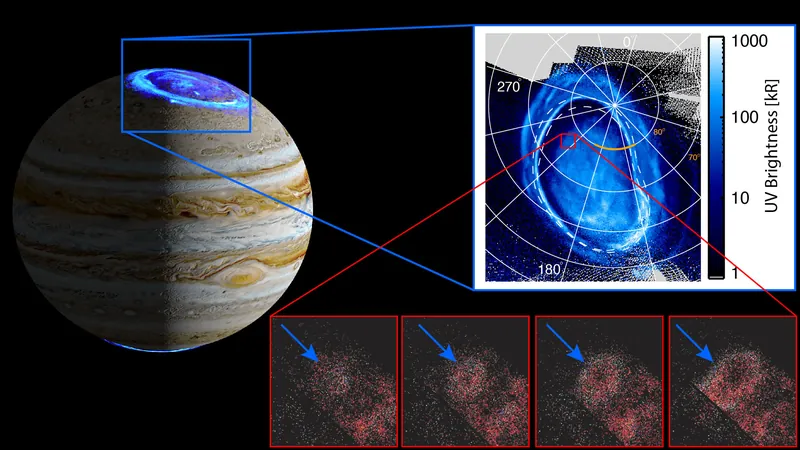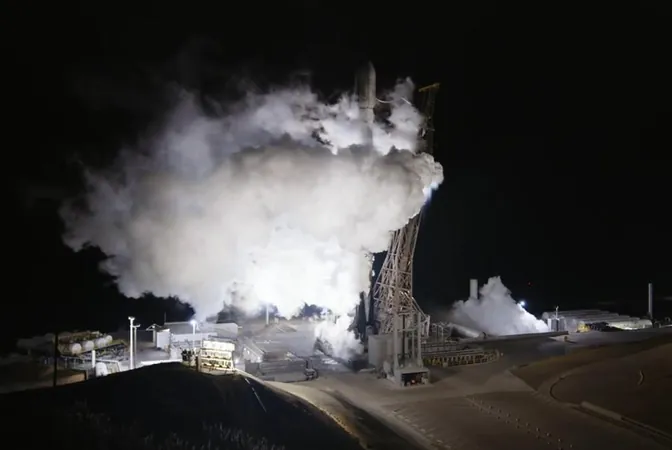
Mysterious 'Alien Auroras' on Jupiter Unveil a New Plasma Wave Phenomenon
2025-08-25
Author: Olivia
Breathtaking auroras dance across the skies of Jupiter, dwarfing Earth's northern lights with a mesmerizing display that’s not just visually stunning but now intricately linked to groundbreaking scientific discoveries.
Researchers from the University of Minnesota Twin Cities have uncovered a spectacular revelation about these 'alien auroras': they are responsible for identifying a brand new type of plasma wave! This exciting finding not only illuminates the chaotic beauty of Jupiter’s atmosphere but could also enhance our understanding of auroras on other planets, shedding light on how magnetic fields shield them—and us—from harmful cosmic radiation.
So, what exactly causes these striking auroras? They emerge when streams of charged particles, guided by a planet's magnetic field, crash into its atmosphere. While our Earth presents a colorful palette of greens and blues in its auroras, Jupiter's storms are much more powerful and can’t be seen by the naked eye without tools that detect ultraviolet or infrared light.
Thanks to NASA's Juno spacecraft—cruising around Jupiter since 2016—scientists have gained unprecedented insights. Juno meticulously charts a path over Jupiter's poles, designed to protect the spacecraft from the planet's severe radiation while capturing crucial measurements.
According to Ali Sulaiman, a co-leader of the study and assistant professor of physics and astronomy at the University of Minnesota, Juno’s capabilities have set it apart: "The James Webb Space Telescope may give us some stunning infrared images, but Juno is the first spacecraft to go polar around Jupiter, providing invaluable data on its auroras."
What’s truly fascinating is the behavior of plasma, often cited as the fourth state of matter, which exists when atoms gain such energy they dissolve into a soup of electrons and ions. While plasma behaves like a liquid, it also reacts robustly to magnetic fields—which is crucial when studying Jupiter, the solar system’s most magnetized planet.
Through Juno's unique measurements, the research team discovered a striking disparity: the plasma density around Jupiter is incredibly low while the magnetic field is exceptionally potent. As a result, this leads to vibrations at surprisingly low frequencies, forming a new wave type that starts as a common Alfvén wave but evolves into a 'Langmuir mode' due to Jupiter’s intense conditions.
Robert Lysak, another co-lead author and professor of physics and astronomy, remarked, "Though plasma flows with fluid-like behavior, it’s also shaped by both its magnetic fields and external forces. This interplay is what we’ve now begun to unravel on Jupiter.”
Interestingly, the way Jupiter's magnetic field directs charged particles differs significantly from Earth's mechanisms. On our planet, auroras form ring-like bands around the poles, whereas Jupiter funnels particles straight into the polar cap, resulting in concentrated and chaotic auroral displays. This unique behavior could hint at similar phenomena on our solar system's outer planets or even massive exoplanets orbiting distant stars.
The research team is just getting started. As Juno continues its exploration around Jupiter, each orbit promises to reveal even more about plasma dynamics under extreme conditions—ultimately helping us understand how our own planet and others are shielded from the relentless assault of stellar radiation.









 Brasil (PT)
Brasil (PT)
 Canada (EN)
Canada (EN)
 Chile (ES)
Chile (ES)
 Česko (CS)
Česko (CS)
 대한민국 (KO)
대한민국 (KO)
 España (ES)
España (ES)
 France (FR)
France (FR)
 Hong Kong (EN)
Hong Kong (EN)
 Italia (IT)
Italia (IT)
 日本 (JA)
日本 (JA)
 Magyarország (HU)
Magyarország (HU)
 Norge (NO)
Norge (NO)
 Polska (PL)
Polska (PL)
 Schweiz (DE)
Schweiz (DE)
 Singapore (EN)
Singapore (EN)
 Sverige (SV)
Sverige (SV)
 Suomi (FI)
Suomi (FI)
 Türkiye (TR)
Türkiye (TR)
 الإمارات العربية المتحدة (AR)
الإمارات العربية المتحدة (AR)